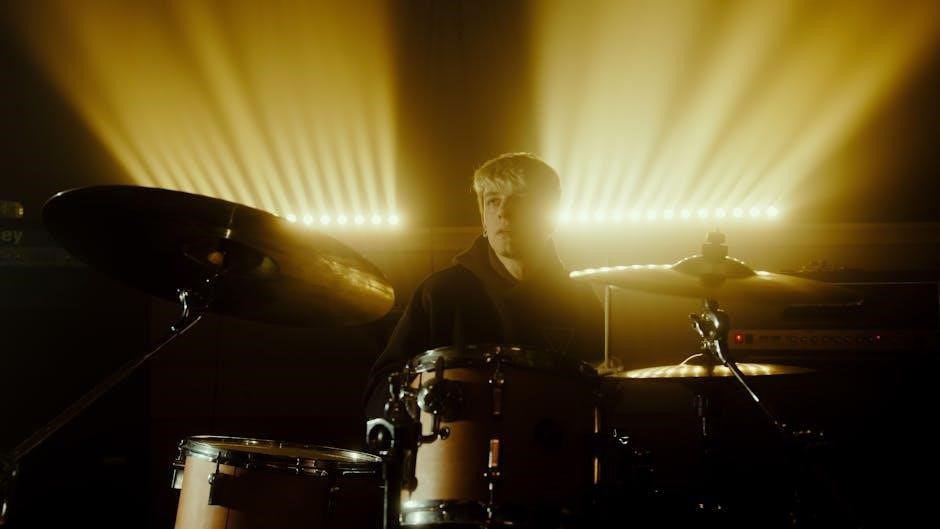The Entertainer, a timeless piano rag by Scott Joplin, embodies the essence of ragtime music. First published in 1902, this composition gained widespread fame in the 1970s through its iconic use in the film The Sting. Known for its lively structure and rhythmic complexity, The Entertainer remains a cornerstone of classical ragtime, inspiring generations of musicians and music enthusiasts alike. Its enduring popularity is evident in its frequent use in media and its accessibility as free sheet music for aspiring pianists.

Scott Joplin’s Background
Scott Joplin (1868–1917) was an African-American composer, pianist, and music teacher. A pivotal figure in ragtime, he wrote over 100 ragtime pieces, an opera, and a ballet, leaving a lasting legacy in American music.
2.1 Early Life and Education
Scott Joplin was born in Texas between June 1867 and January 1868. His mother, a singer and banjo player, introduced him to music early. The family moved to Texarkana, where Joplin received piano lessons from local teachers. His talent flourished under Julius Weiss, a German music teacher, who provided formal training. This foundational education shaped Joplin’s musical skills and laid the groundwork for his future as a composer and pianist.
2.2 Career Highlights
Scott Joplin’s career soared with ragtime compositions like Maple Leaf Rag and The Entertainer. In 1894, he moved to Sedalia, Missouri, teaching piano and composing. By 1902, The Entertainer was published, solidifying his fame. Joplin also explored opera, writing Treemonisha, though it was underappreciated in his lifetime. His works, blending African-American musical traditions with classical forms, revolutionized American music and earned him the title “King of Ragtime.”
2.3 Legacy
Scott Joplin’s legacy as the “King of Ragtime” endures through compositions like The Entertainer, which revitalized interest in ragtime during the 1970s. His work bridges African-American musical traditions with classical forms, influencing generations. The Entertainer’s use in The Sting and its chart-topping success in 1974 solidified its cultural impact, making it a staple in American music history and a timeless inspiration for modern adaptations and media appearances.

The Composition
The Entertainer, published in 1902 as sheet music and piano rolls, is a classic ragtime two-step in C Major, reflecting Joplin’s mastery of the form.
3.1 Musical Structure

The Entertainer adheres to the traditional ragtime structure, with a repeating pattern of intro, theme, and variations. Its syncopated rhythms and harmonic progressions create a lively, danceable feel. The composition is structured in repeating sections, with the intro setting the tone for the main themes, which are developed and varied throughout the piece. This structure showcases Joplin’s skill in blending complexity with accessibility, making it a timeless classic;
3.2 Historical Context
The Entertainer, composed by Scott Joplin in 1902, represents the pinnacle of ragtime music. Initially published as sheet music, it gained widespread popularity during the ragtime revival of the 1970s, particularly after its use in the film The Sting. This piece reflects the cultural and musical shifts of its time, blending African-American musical traditions with classical forms. Its enduring appeal lies in its rhythmic vitality and historical significance.
3.3 Publication Details
The Entertainer was first published in 1902 by John Stark & Son. Initially released as sheet music, it later became available as piano rolls for player pianos. The composition gained renewed popularity in 1928 with its first recording by the Blue Boys, performed on mandolin and guitar. These formats ensured its widespread accessibility, contributing to its lasting influence and appeal across generations of musicians and music enthusiasts.
Sheet Music Availability
The Entertainer sheet music is freely available in PDF format from multiple sources, including bossPianoSheets.com and free-scores.com, offering various arrangements for piano, guitar, and more.
4.1 Sources for Download
The Entertainer sheet music is widely available for download from reputable sources like bossPianoSheets.com, free-scores.com, and 8notes.com. These platforms offer free PDF downloads, ensuring easy access for pianists of all skill levels. Many sites provide multiple arrangements, including piano solo, guitar, and flute versions, catering to diverse musical preferences and needs.
4.2 Formats and Arrangements
The Entertainer is available in multiple formats, including PDF, MIDI, and digital sheet music. Arrangements range from piano solo to guitar, flute, and even piano duets. Many platforms, such as MuseScore and 8notes, offer easy versions for beginners and advanced adaptations. Guitar transcriptions and simplified editions cater to diverse skill levels, ensuring accessibility for musicians of all backgrounds and preferences.
4.3 Tips for Learners
Beginners can start with simplified versions of The Entertainer to grasp the rhythm and structure. Practice the piece in slower tempos to master complex passages. Break the composition into sections and gradually combine them. Utilize online tutorials and guides for additional support. Emphasize maintaining a steady tempo, as ragtime relies heavily on precise timing. Intermediate learners can explore more intricate arrangements to refine their skills and build confidence in performing this classic piece.

Performance and Interpretation
The Entertainer shines with dynamic contrasts and syncopated rhythms. Performers should maintain a steady tempo, emphasizing the lively spirit of ragtime while adding personal flair for engagement.
5.1 Techniques for Playing
Mastering The Entertainer requires precise timing and rhythmic accuracy. Emphasize syncopation and dynamic contrasts, maintaining a steady tempo throughout. Practice slower sections to build dexterity and control. Pay attention to articulation, using legato for melodies and staccato for rhythmic accents. Dynamics, such as crescendos and diminuendos, add depth to the performance. Start with a moderate pace and gradually increase speed as confidence grows, ensuring clarity in complex passages.
5.2 Notable Performances
The Entertainer gained global recognition through its iconic use in the 1973 film The Sting, where Marvin Hamlisch’s adaptation topped charts, reaching number 3 on Billboard. Lara Borst’s piano rendition and orchestral arrangements by Gunther Schuller and David Bruce further popularized the piece. Various artists have performed it, showcasing its versatility across genres and instruments, from piano solos to ensemble adaptations, ensuring its timeless appeal and widespread accessibility through sheet music and recordings.
Connection to “The Sting”
The Entertainer’s 1973 use in the Oscar-winning film The Sting sparked a ragtime revival, with Marvin Hamlisch’s adaptation reaching number 3 on Billboard in 1974.
6.1 Use in the Film
The Entertainer became synonymous with the 1973 Oscar-winning film The Sting, where it served as the main theme. Its lively ragtime rhythm perfectly complemented the film’s narrative, enhancing its nostalgic and whimsical tone. The adaptation by Marvin Hamlisch for a larger orchestra added depth, making it a cornerstone of the movie’s success and a key factor in its cultural resurgence during the 1970s ragtime revival.
6.2 Ragtime Revival
The Entertainer played a pivotal role in the 1970s ragtime revival, sparked by its use in The Sting. The film’s soundtrack, arranged by Marvin Hamlisch, reintroduced Joplin’s work to a new generation, propelling the piece to chart-topping success. This resurgence brought ragtime back into mainstream culture, influencing music and media, and cementing The Entertainer as a timeless classic that continues to inspire artists and audiences worldwide.
Cultural Impact
The Entertainer significantly influenced music and media, sparking the ragtime revival and becoming a cultural icon. Its enduring popularity endures through its use in films, TV, and commercials.
7.1 Influence on Music
The Entertainer played a pivotal role in the ragtime revival of the 1970s, inspiring a new generation of musicians. Its rhythmic complexity and syncopated melodies influenced jazz, blues, and pop music. The piece’s timeless appeal has made it a cornerstone of piano education, with its sheet music remaining widely popular. Its success in The Sting and subsequent chart-topping adaptations further solidified its impact on music history, ensuring its enduring legacy as a cultural icon.
7.2 Popularity in Media
The Entertainer gained widespread recognition through its iconic use in the 1973 film The Sting, where it served as the theme music. This exposure led to a surge in popularity, with Marvin Hamlisch’s adaptation reaching number 3 on the Billboard pop chart in 1974. The piece has since been featured in numerous TV shows, commercials, and films, cementing its status as a cultural phenomenon and a timeless classic in American music history.

Educational Resources
The Entertainer offers a wealth of educational resources, including tutorials, guides, and workshops. These materials cater to musicians of all levels, providing insights into ragtime techniques and interpretation, ensuring a comprehensive learning experience for enthusiasts and students alike.
8.1 Tutorials and Guides
Tutorials and guides for The Entertainer are widely available online, offering step-by-step instructions for mastering the piece. Platforms like MuseScore and 8notes provide detailed scores and arrangements, while video tutorials on YouTube and piano learning apps break down complex sections. These resources cater to all skill levels, from beginners to advanced pianists, ensuring a comprehensive learning experience. Interactive tools and practice guides further enhance understanding of the composition’s rhythm and technique.
8.2 Workshops and Courses
Workshops and courses dedicated to The Entertainer offer in-depth learning experiences. Piano teachers and institutions provide structured lessons, focusing on mastering the piece’s intricate rhythms. Online platforms host interactive workshops, while music schools offer hands-on sessions. These programs often include video masterclasses, historical insights, and performance tips. Designed for intermediate to advanced pianists, they aim to refine technique and deepen understanding of Joplin’s iconic composition.
Modern Adaptations
The Entertainer has inspired numerous modern adaptations, including arrangements for various instruments and electronic remixes. These reinterpretations preserve the original charm while introducing fresh, contemporary flavors to Joplin’s timeless classic.
9.1 Contemporary Covers
Contemporary covers of The Entertainer showcase its timeless appeal, with arrangements for piano duo, guitar, and vibraphone. Artists like Lara Borst and V. Maksimenko offer unique interpretations, blending traditional ragtime with modern flair. These covers, available in PDF and MIDI formats, cater to diverse skill levels, making the piece accessible to both professionals and learners. They highlight the enduring versatility of Joplin’s composition in today’s musical landscape.
9.2 Remixes and Sampling
The Entertainer has inspired numerous remixes and samplings, blending ragtime with modern genres like electronic and hip-hop. These reinterpretations, often available as downloadable PDFs or MIDI files, breathe new life into the classic piece. Remixes by contemporary artists showcase its adaptability, while samples in popular tracks introduce Joplin’s work to fresh audiences, highlighting its enduring influence on global music culture and creativity.
The Entertainer, composed by Scott Joplin, stands as a timeless masterpiece of ragtime music. Originally published in 1902, it gained renewed popularity in the 1970s through its iconic use in The Sting. As a cornerstone of American musical heritage, it continues to inspire both professional musicians and learners. With its sheet music widely available, The Entertainer remains a celebrated piece, bridging generations and cultures, ensuring Joplin’s legacy endures as a pioneer of ragtime.